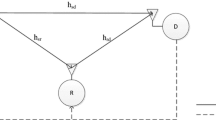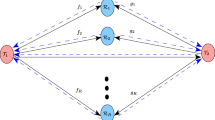Abstract
In this paper, we present a hierarchical modulation-based cooperation (HMC) scheme to overcome capacity degradation due to half-duplex transmissions in conventional cooperative relay systems. In the HMC scheme, two relay terminals are used for both transmit and receive operations, i.e., full-duplex transmission. This scheme reduces the required number of time slots for cooperation. Utilizing this cooperative mechanism, the HMC scheme achieves cooperative diversity at the destination node by combining the signals delivered from the source and relay nodes. In addition, we derive a closed form of the end-to-end bit error rate for the HMC scheme, which is utilized to determine an optimal power ratio for hierarchical signals at the source node. In concurrence with the HMC scheme, we develop the best relay selection scheme for a practical wireless communication networks.












Similar content being viewed by others
References
Boyer, J., Falconer, D., & Yanikomeroglu, H. (2004). Multihop diversity in wireless relaying channels. IEEE Transactions on Communications, 52, 1820–1830.
Laneman, J., Tse, D., & Wornell G. (2004). Cooperative diversity in wireless networks: Efficient protocols and outage behavior. IEEE Transactions on Information Theory, 50, 3062–3080.
Kramer, G., Gastpar, M., & Gupta, P. (2005). Cooperative strategies and capacity theorems for relay networks. IEEE Transactions on Information Theory, 51, 3037–3063.
Tse D., & Viswanath P. (2005). Fundmentals of wireless communications. Cambridge: Cambridge University Press.
Jiang, H., & Wilford, P. (2005). A hierarchical modulation for upgrading digital broadcast systems. IEEE Transactions on Broadcasting, 51, 223–229.
Larsson, E.& Vojcic, B. (2005). Cooperative transmit diversity based on superposition modulation. IEEE Communications Letters, 9, 778–780.
Ding, Z., Ratnarajah, T., & Cowan, C. (2006). Cooperative multiple access systems using superposition modulation. IEEE Information Theory Workshop (ITW’06),497–501, March 2006.
Hausl, C., & Hagenauer, J. (2006). Relay communication with hierarchical modulation. IEEE Communications Letters, 54, 64–66.
Lee, K., & Cho, D. (2007). Hierarchical constellation based adaptive relay scheme in multi-hop networks. IEEE Commun. Letters, 3, pp. 225–227, March 2007.
Hyunseok Ryu, C.K., & Kwon, D. (2007). Transmission protocol for cooperative MIMO with full rate: Design and analysis. IEEE Vehicular Technology Conference (VTC’2007), 934–938, April 2007.
Fan, Y. Wang, C., Thompson, J., & Poor, H. V. (2007). Recovering multiplexing loss through successive relaying using repetition coding. IEEE Transactions on Wireless Communications, 6, 4484–4493.
Rankov, B., Wittneben, A. (2006). Achievable rate regions for the two-way relay channel. IEEE International Symposium on Information Theory (ISIT), 1668–1672, July 2006.
Rankov, B., & Wittneben, A. (2007). Spectral efficient protocols for half-duplex fading relay channels. IEEE Journal on Selected Areas in Communications, 25, 379–389.
Popovski P., Yomo, H. (2007). Wireless network coding by amplify and forward for bi-directional traffic flows. IEEE Communications Letters, 11, 16–18.
Popovski, P., & Yomo, H. (2007). Physical network coding in two-relay wireless relay channels. IEEE International Conference on Communications (ICC), 707–711, June 2007.
Louie, R.. Li, Y., & Vucetic, B. (2010). Practical phisical layer network coding for two-way relay channels: Performance analysis and comparison. IEEE Transactions on Wireless Communications, 9, 764–777.
Popovski, P., & Yomo, H. (2006). The anti-packets can increase the achievable throughput of a wireless multi-hop network. IEEE International Conference on Communications (ICC), 9, 3885–3890, June 2006.
Ibrahim, A. S., Sadek, A. K., Su, W., & Liu K. J. R. (2008). Cooperative communications with relay-selection: When to cooperate and whom to cooperate with. IEEE Transactions on Wireless Communications, 7, 2814–2827.
Tannious, R., & Nosratinia, A. (2007). Grouping and partner selection in cooperative wireless networks. IEEE Journal on Selected Areas Communication, 26, 1419–1428.
Nosratinia, A., & Hunter, T. (2007). Grouping and partner selection in cooperative wireless networks. IEEE Journal on Selected Areas Communication, 25, 369–378.
ETSI. (2004). Digital video broadcasting (DVB): Framing structure, channel coding and modulation for digital terrestrial television.EN 300 744, V1.5.1, Nov 2004.
Bletsas A., Khisti A., Reed D. P., & Lippman A. (2006). A simple cooperative diversity method based on network path selection. IEEE Journal on Selected Areas Communication, 24, 659–672.
Shan, H., Zhuang, W., & Wang, Z. (2009). Cooperation or not in mobile ad hoc networks: A MAC perspective. IEEE International Conference on Communications (ICC), June 2009.
Marchenko, N., Yanmaz, E., Adam, H., & Bettstetter, C. (2009). Selecting a spatially efficient cooperative relay. IEEE Global Telecommunications Conference (GLOBECOM), Nov. 2009.
Acknowledgments
This research was supported by Basic Science Research Program through the National Research Foundation of Korea (NRF) funded by the Ministry of Education, Science and Technology (2010-0011995). This work was supported by the IT R&D program of MKE/KEIT. [KI002091, Research on Multiple Antenna and Multi-hop Relay Transmission Technologies for Next Generation Mobile Broadcasting Service].
Author information
Authors and Affiliations
Corresponding author
Rights and permissions
About this article
Cite this article
Son, H., Park, J. & Lee, S. Hierarchical modulation-based cooperation utilizing relay-assistant full-duplex diversity. Wireless Netw 17, 583–595 (2011). https://doi.org/10.1007/s11276-010-0298-3
Published:
Issue Date:
DOI: https://doi.org/10.1007/s11276-010-0298-3




